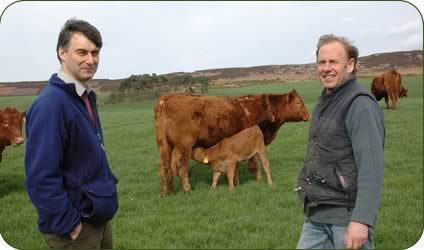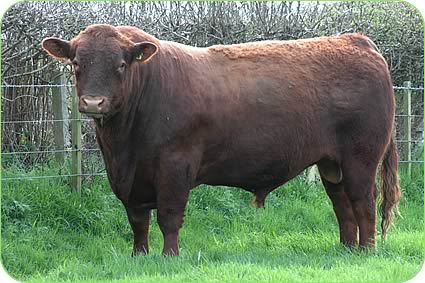Jennifer MacKenzie is an agricultural photo journalist with almost 30 year's experience. Operating from her base in Cumbria, Jennifer undertakes mainly industry-related freelance writing and photography.
Stabiliser the ideal suckler cow
The introduction of the composite beef breed, the Stabiliser, has led to a home-bred replacement policy with the suckler herd on the in-hand farming operation at Lilburn Estates, near Wooler, and the benefits in herd bio-security as well as reduced replacement costs.
 |
| A pure-bred Stabiliser heifer and calf. |
A Stabiliser breeding programme was established in 1999 also with sustainable beef production at the fore and the low input, early maturing cattle are meeting a number of objectives, says the estate’s farm manager Ray Field.
Cost savings are already helping to fill the minimum £200 a head gap lost in subsidies under the new Single Farm Payment.
The quest to find a superior suckler cow which avoided Holstein type herd replacements was begun by Mr Field’s predecessor David Sandiford with the use of the South Devon on Limousin-Holstein cows.
He had been considering the Stabliser and when Mr Field took on the job he believed that the cattle – a composite of four pure beef breeds, Gelbvieh, Hereford, Red Angus and Simmental – could offer a lot to the system at Lilburn.
One of the big attractions to the Stabiliser, bred to be the ideal suckler cow to be used with continental crosses, was the huge gene pool available in the United States, unlike if the estate had set about creating its own hybrid cattle from British breeds.
An AI programme was started in 2000 through the Beef Improvement Group (BIG) with the insemination of 90 heifers with calves born in the spring of 2001.
“The cows were easily calved to the Stabiliser bull and the calves were very even in their type, even on a first cross.
“With those first calves we liked what we saw. They grew quickly and had a lot of vigour when they were born. Despite the fact that they were small when they were born they had good growth rates,” said Mr Field.
 |
| Lilburn Estates' farm manager Ray Field, left, with farm steward David Heads who is responsible for the Stabiliser heifers. |
To speed up the establishment of the herd, four embryo transfer programmes were subsequently carried out each using between 80 and 90 females, achieving a creditable conception rate of around 50 per cent each programme.
The majority of Stabiliser cross females have been retained for the herd which now numbers 300 F1, and F2 crosses which have calved this spring with the first purebred cattle calving last autumn.
Lilburn Estate, which is owned by Duncan Davidson, runs a herd of more than 1,100 suckler cows on its large in-hand farming operation producing 800 finishing cattle.
Six continental and 18 Stabiliser bulls are run with the suckler herd.
The operation has 5,450 acres of combinable crop, 5,285 acres of lowland grass, 155 acres of forage crops, 14,600 acres of hill and heather grouse moor and 2,300acres of woodland.
The farms also run a breeding and finishing sheep enterprise totally more than 28,000 head.
With the cattle enterprise, the aim is to establish a herd of up to 350 pure Stabiliser sucklers, currently there are 50 pure-bred females. Once the herd is pure then it is possible that they will be crossed back to the Charolais or a continental cross bull to maintain hybrid vigour.
“We’re using 75 per cent of Stabiliser bulls across the entire suckler cow herd now and we’re not buying any other bulls,” said Mr Field.
“A spin-off from the ET programme was that we were able to produce our own bulls which saved us buying additional herd sires. Sales of bulls have also gone a long way to offset the cost of the ET work,” he added.
Up to 10 bulls have been sold privately across the country, mainly for use on dairy-bred heifers. Because of their early maturity and fertility, they are ready to work at 18 to 20 months old on as many as 40 cows.
Mr Field’s concern is whether, post CAP reform, beef production will be sustainable. The estate is finding numerous cost benefits with the Stabiliser enterprise.
The home-bred replacement policy is estimated at cutting replacement costs by half, saving £250 to £300 per head.
Breeding females also make efficient use of grass, receiving only up to 10kg a head of concentrate up to calving at two years old.
Veterinary costs are minimised by a reduced number of calving difficulties as well as not buying in replacements and the estate’s health policy in which the entire herd is screened for Leptospirosis, BVD and Johne’s disease and all breeding and yearling bulls are semen tested.
Management benefits include the control of genetics and the ability to ensure uniform animal populations with a home-bred replacement policy.
Other management benefits include a low birth weight and resultant easy calving as well as improved fertility and early maturity which does not comprise longevity.
 |
| One of the Lilburn Estate's Stabiliser stock bulls aged three and a half and bred by Richard Fuller, at Givendale. |
The Stabilisers are good on their feet with no cattle needing attention and the temperament is docile.
“Because the calves are small when they are born there is no stress on the cows when they are calving. We look at the cows when calving at around 7pm and we don’t go back to them until the next morning,” said Mr Field.
“Not only is it labour saving but we have few birthing problems and no caesareans unlike with continental sired cattle.
Currently, the policy is to keep all male cattle entire, finishing at between 12 and 14 months old on a grain beet ration consisting of wet maize meal dry sugar beet pulp and bread.
Stabiliser bulls have been found to give an equal or better performance than continental bulls with an average deadweight carcase weight of 310 to 320kg and an average liveweight of 590kg at finishing, grading at U and R4L averaging 180-195p per kilo deadweight.
By finishing bulls at this age rather than keeping them longer as steers, it enables more cattle to be kept on the farm.
The majority of cattle, including continental cross heifers finished on grass and silage at 18-24 months are sold deadweight to whoever pays the best price, after all off takes.
Heifers are sold at an average liveweight of 540kg, with deadweight carcase weight of 285kg to 290kg. All Stabiliser suitable heifers are currently kept for breeding.
The majority of the Stabiliser sucklers are housed in covered loose yards on an estate added to Lilburn two years ago but they are equally able to be outwintered as some of the down calving heifers are.
During the winter the cattle are fed on a silage based diet with the autumn-calving heifers being fed a small amount of rolled barley and the autumn born calves are creep fed.
With the estate’s sheep enterprise, the aim is again to minimise disease risk by being self-sufficient in sheep replacements, a decision taken in 2001.
There is a flock of almost 6,000 pure Blackface ewes, drafts of which are crossed with the Bluefaced Leicester to produce the Mule.
First cross Suffolks from the Mule ewes are then crossed with the Texel without any loss of prolificacy.

